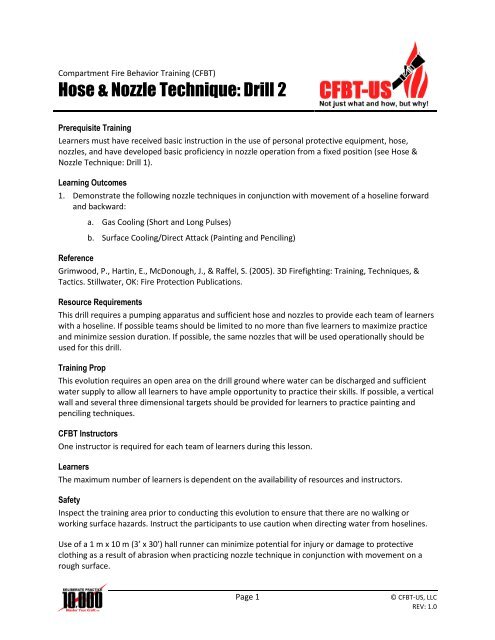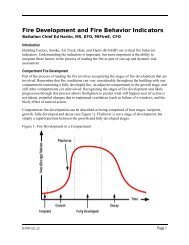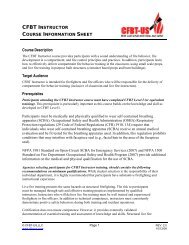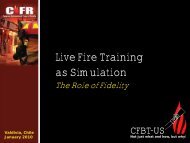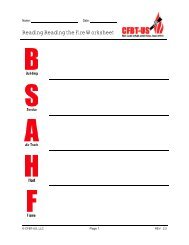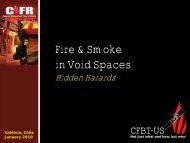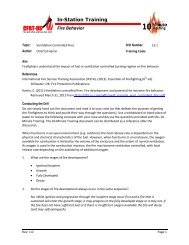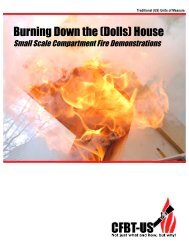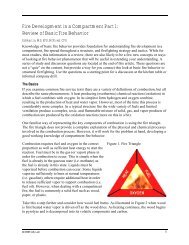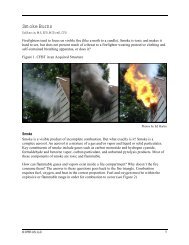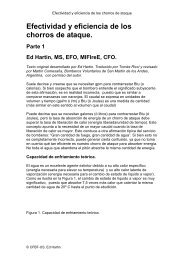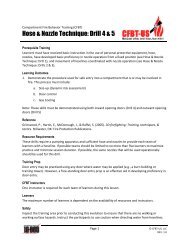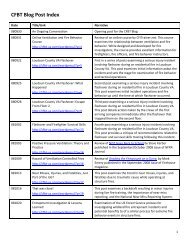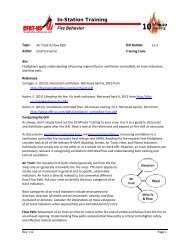Hose & Nozzle Technique Drill 2: Maneuver and - CFBT-US!
Hose & Nozzle Technique Drill 2: Maneuver and - CFBT-US!
Hose & Nozzle Technique Drill 2: Maneuver and - CFBT-US!
Create successful ePaper yourself
Turn your PDF publications into a flip-book with our unique Google optimized e-Paper software.
Compartment Fire Behavior Training (<strong>CFBT</strong>)<br />
<strong>Hose</strong> & <strong>Nozzle</strong> <strong>Technique</strong>: <strong>Drill</strong> 2<br />
Prerequisite Training<br />
Learners must have received basic instruction in the use of personal protective equipment, hose,<br />
nozzles, <strong>and</strong> have developed basic proficiency in nozzle operation from a fixed position (see <strong>Hose</strong> &<br />
<strong>Nozzle</strong> <strong>Technique</strong>: <strong>Drill</strong> 1).<br />
Learning Outcomes<br />
1. Demonstrate the following nozzle techniques in conjunction with movement of a hoseline forward<br />
<strong>and</strong> backward:<br />
a. Gas Cooling (Short <strong>and</strong> Long Pulses)<br />
b. Surface Cooling/Direct Attack (Painting <strong>and</strong> Penciling)<br />
Reference<br />
Grimwood, P., Hartin, E., McDonough, J., & Raffel, S. (2005). 3D Firefighting: Training, <strong>Technique</strong>s, &<br />
Tactics. Stillwater, OK: Fire Protection Publications.<br />
Resource Requirements<br />
This drill requires a pumping apparatus <strong>and</strong> sufficient hose <strong>and</strong> nozzles to provide each team of learners<br />
with a hoseline. If possible teams should be limited to no more than five learners to maximize practice<br />
<strong>and</strong> minimize session duration. If possible, the same nozzles that will be used operationally should be<br />
used for this drill.<br />
Training Prop<br />
This evolution requires an open area on the drill ground where water can be discharged <strong>and</strong> sufficient<br />
water supply to allow all learners to have ample opportunity to practice their skills. If possible, a vertical<br />
wall <strong>and</strong> several three dimensional targets should be provided for learners to practice painting <strong>and</strong><br />
penciling techniques.<br />
<strong>CFBT</strong> Instructors<br />
One instructor is required for each team of learners during this lesson.<br />
Learners<br />
The maximum number of learners is dependent on the availability of resources <strong>and</strong> instructors.<br />
Safety<br />
Inspect the training area prior to conducting this evolution to ensure that there are no walking or<br />
working surface hazards. Instruct the participants to use caution when directing water from hoselines.<br />
Use of a 1 m x 10 m (3’ x 30’) hall runner can minimize potential for injury or damage to protective<br />
clothing as a result of abrasion when practicing nozzle technique in conjunction with movement on a<br />
rough surface.<br />
Page 1 © <strong>CFBT</strong>-<strong>US</strong>, LLC<br />
REV: 1.0
HOSE AND NOZZLE TECHNIQUE DRILL 2<br />
Personal Protective Equipment<br />
Learners should wear structural firefighting clothing <strong>and</strong> self-contained breathing apparatus during this<br />
drill. However, in hot weather session duration should be limited.<br />
Scene Control<br />
Scene control will vary to some extent based on the specific training location. The immediate training<br />
area will be limited to participants <strong>and</strong> (accompanied) observers of the training activity.<br />
If in-service apparatus is at the training location, position it to ensure ease of egress.<br />
Instructional Activities<br />
This lesson involves the following instructional activities. Base your instructional approach on learners<br />
experience level <strong>and</strong> underst<strong>and</strong>ing as the lesson progresses.<br />
Firefighters often perceive that gas cooling will slow advancement of the hoseline (based on the<br />
perceived need to stop <strong>and</strong> apply water before advancing). However, a skilled nozzle operator can<br />
generally apply short pulses while moving. Long pulses as needed to deal with larger spaces or more<br />
severe fire conditions will generally require the hose team to stop, apply water, <strong>and</strong> assess conditions<br />
before advancing.<br />
1. Provide a quick review of nozzle technique <strong>and</strong> the skills that learners will be practicing.<br />
a. Short Pulse: Have the learners imagine opening <strong>and</strong> closing the nozzle as quickly as<br />
possible. Then tell them that the short pulse is slightly quicker than that (to emphasize<br />
that this needs to be an extremely short application of water). Water hammer is not an<br />
issue due to the minimal duration of the pulse <strong>and</strong> small amount of water involved.<br />
b. Long Pulse: A long pulse is anything longer than a short pulse. The duration of long<br />
pulses is dependent on compartment configuration <strong>and</strong> fire conditions. In practicing this<br />
skill, learners should apply pulses from several seconds up to 15 or 20 seconds. The long<br />
pulse requires that the nozzle be opened quickly (to provide maximum pressure <strong>and</strong><br />
obtain the desired droplet size) <strong>and</strong> closed relatively slowly (to minimize potential for<br />
water hammer).<br />
c. Painting: Developing a thin film of water on a hot surface requires gentle application.<br />
This requires opening the nozzle only enough for water to reach the intended target.<br />
Overly vigorous application results in water bouncing off <strong>and</strong> not cooling the intended<br />
surface.<br />
d. Penciling: Penciling is similar to pulsing (short or long), but with a straight stream. This<br />
technique is used to maximize reach when applying water to hot surfaces. Brief<br />
application uses the same quick operation of the nozzle shutoff as a short pulse, longer<br />
application requires quick opening <strong>and</strong> slower closing of the shutoff in the same manner<br />
as a long pulse.<br />
2. Demonstrate the position of the nozzle operator <strong>and</strong> other members of the hose team when<br />
working with a charged hoseline. The number of personnel used should reflect the learners’<br />
operational reality (e.g., don’t use three or four firefighters on a hoseline if they will typically<br />
operate with two).<br />
Page 2 © <strong>CFBT</strong>-<strong>US</strong>, LLC<br />
REV: 1.0
HOSE AND NOZZLE TECHNIQUE DRILL 2<br />
a. The nozzle operator needs to maintain control of the nozzle at all times <strong>and</strong> be aware of<br />
the pattern setting (review how to resent when working in a dark or smoke logged<br />
space).<br />
b. Backup firefighter should be close (but not too close). Gas cooling requires that the hose<br />
behind the nozzle operator be lower than the nozzle (at higher flow rates it should be<br />
on the floor to redirect nozzle reaction.<br />
3. Have the learners practice moving the hoseline forward <strong>and</strong> backward in conjunction with<br />
nozzle operation (short <strong>and</strong> long pulses, penciling, <strong>and</strong> painting).<br />
a. Keep nozzle out in front (don’t hug the nozzle) to permit good control<br />
b. Don’t walk if you can’t see your feet.<br />
c. When advancing, the backup firefighter must avoid being trapped between the hose<br />
<strong>and</strong> inside corners or doorways (always work to the outside of corners).<br />
d. The nozzle operator scans to the front <strong>and</strong> sides for important fire behavior indicators<br />
<strong>and</strong> l<strong>and</strong>marks. The backup firefighter is responsible for observing to the rear <strong>and</strong> to the<br />
sides. Communication between the nozzle operator <strong>and</strong> backup firefighter is critical.<br />
e. Being able to move the hoseline backward as well as forward is also an important skill<br />
(e.g., when using a hoseline to support primary search or in the event of a tactical<br />
withdrawal).<br />
4. Have the learners practice each technique (short pulse, long pulse, painting <strong>and</strong> penciling).<br />
The instructor should provide h<strong>and</strong>s-off, diagnostic feedback to assist the students in mastering<br />
each of the skills. Learners should develop proficiency in each skill prior to moving on to the next.<br />
5. Debrief all participants focusing on observations <strong>and</strong> conclusions.<br />
Integration<br />
<strong>Hose</strong> <strong>and</strong> <strong>Nozzle</strong> <strong>Technique</strong> <strong>Drill</strong> 2 can be used as a st<strong>and</strong>-alone training exercise or elements of this drill<br />
can be integrated into other training activity. For example, when conducting hose evolutions (focused<br />
on deployment of supply <strong>and</strong> attack lines), elements of <strong>Hose</strong> <strong>and</strong> <strong>Nozzle</strong> <strong>Technique</strong> <strong>Drill</strong> 2 can be<br />
integrated with deployment of attack lines. In fact, any time that a charged line is being used for training<br />
focused on structural firefighting, elements of this drill can be integrated to maximize the effectiveness<br />
<strong>and</strong> efficiency of training in nozzle techniques.<br />
Page 3 © <strong>CFBT</strong>-<strong>US</strong>, LLC<br />
REV: 1.0


